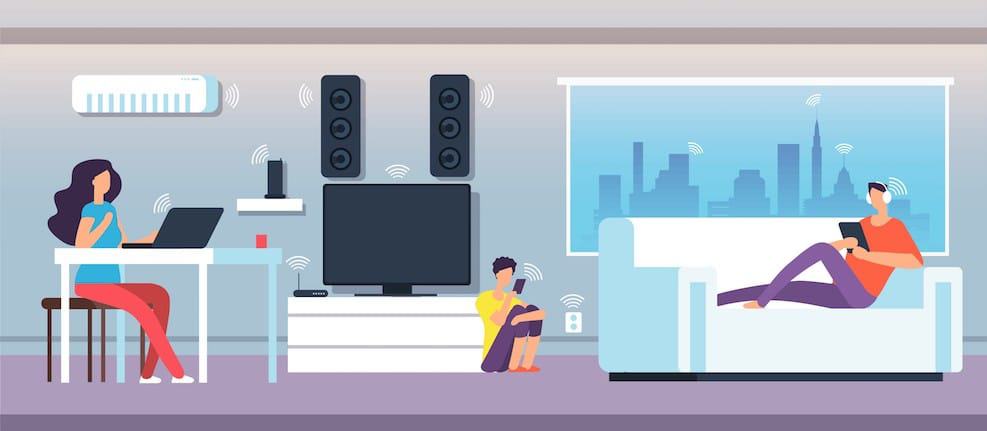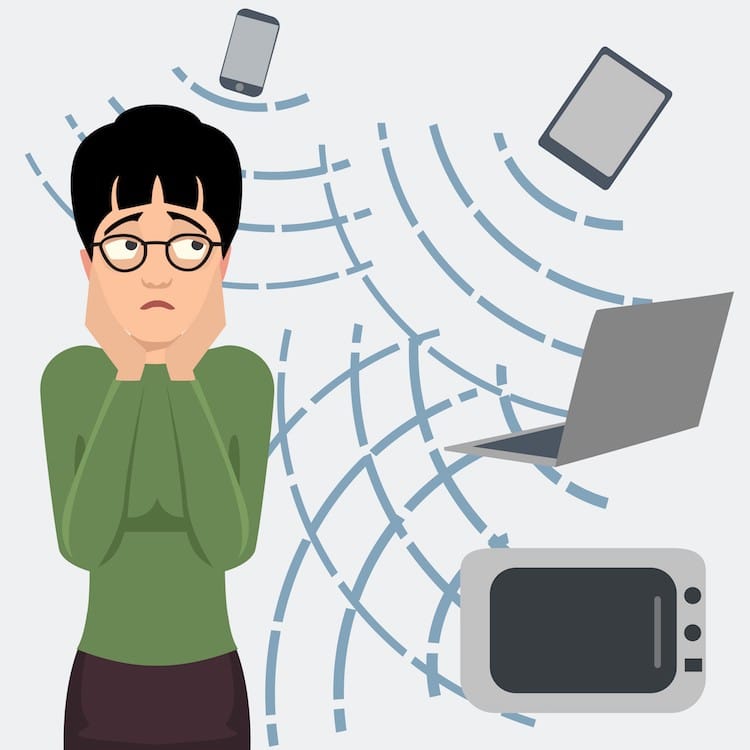In AMC’s fictional cable TV series Better Call Saul, Saul’s older brother, Charles Lindbergh “Chuck” McGill, is convinced he suffers from electromagnetic hypersensitivity (EHS) — often described as an “allergy” to electric and magnetic fields.
Symptoms include anxiety, depression, headaches, itchy skin, blurred vision, and heart palpitations. The condition forces Chuck to move to an electricity-free home, using gas lamps for light and foregoing many other modern conveniences.
Visitors, including Chuck’s younger brother Jimmy, are forced to place their electronic devices in the mailbox and ground themselves to discharge any static electricity before entering his home. Chuck even wraps himself in what Jimmy describes as a “space blanket” to shield himself from any electromagnetic fields (EMFs).
Fast forward to the real world, where the introduction of 5G networks promises to deliver ultrafast data and connectivity to our mobile devices, and Chuck’s precautions seemfairly sensible — especially when you consider EMF radiation has been implicated as a possible cause of anxiety, depression, fatigue, and even cancer in humans, along with the deaths of large populations of bees and birds near 5G cell phone towers.
However, the truth about EMFs and their potential for causing illness in humans is far less dramatic. In this post, we separate fact from fiction and present practical precautions for keeping you and your family safe and healthy.
What are EMFs?
Electromagnetic fields (EMFs) are invisible energy waves produced through the motion of electrically charged particles. Sources of EMFs can be divided into two categories:
- Natural: Natural sources of EMFs include electrical charges in the atmosphere associated with thunderstorms; magnetic fields created by planets, stars, and moons; radiation from the sun; static electricity; and the body’s own electro-chemical reactions.
- Human-made: Sources of human-made EMFs include X-rays, power lines (outside and inside homes and businesses), TV and radio station frequency emissions, mobile cell phone towers, and Internet routers.
Diving a little deeper, EMFs can be categorized as ionizing and non-ionizing:
- Ionizing: Ionizing EMFs carry enough energy to break bonds between molecules. Sources of ionizing EMFs include radioactive materials, cosmic rays (such as those from the sun), and X-rays.
- Non-ionizing: Non-ionizing EMFs do not have enough energy to break molecular bonds. Sources of non-ionizing EMFs include electrical power lines, microwaves, and TV and radio frequency signals.
Ionizing EMFs have a much greater potential than non-ionizing EMFs for negatively impacting health.
Finally, EMFs can be categorized by frequency:
-
Extremely low frequency (ELF): EMFs with frequencies up to 300 Hz are considered ELFs. Sources of ELFs include the power supply and most electrical appliances in your home.
-
Intermediate frequency (IF): EMFs with frequencies from 300 Hz to 10 MHz are considered IFs. Sources of IF include computer screens, anti-theft devices, and home and industrial security systems.
-
Radiofrequency (RF): EMFs with frequencies over 10 MHz are considered RFs. Sources of RFs include radio, television, and radar antennas; cellular telephone towers; and microwave ovens.
These fields induce currents in the human body, and if the signal is strong enough, they can produce biological effects such as heating and electrical shock. However, RF signals need to be far stronger than those normally occurring to produce these effects.
How dangerous are EMFs?
EMFs have the potential to negatively impact the nervous system and damage cells, which can create or perpetuate common health problems, including poor sleep, abnormal cell growth (cancer), anxiety, depression, fatigue, and pain.
However, health effects vary considerably depending on a variety of factors, including the following:
- A person’s sensitivity to EMFs: Some people are more sensitive than others, as was clearly the case with Chuck on Better Call Saul.
- EMF frequency and amplitude: Stronger EMFs (higher frequencies and amplitudes) have a greater potential for creating negative health effects. However, most people are generally exposed the weaker EMFs that have not been proven, so far, to have a negative impact on human health.
- Distance: EMFs are strongest closest to the source and weaken with distance.
When it recently weighed in on the question about the dangers associated with EMFs, the World Health Organization (WHO) concluded, “There is no doubt that short-term exposure to very high levels of electromagnetic fields can be harmful to health.”
However, “Despite extensive research, to date there is no evidence to conclude that exposure to low level electromagnetic fields is harmful to human health.”
So, to answer the question “How dangerous are EMFs?” you really need to look at your exposure and how sensitive you are to EMFs. For example, if you work in or near a server room or battery backup (inverter) room, or you live very close to power lines, your exposure to EMFs may be high enough to cause health issues.
Staying healthy in a toxic world
We are surrounded by power sources, electronic devices, cell phone towers, TV and radio broadcasting stations, and other sources of EMFs in addition to natural EMFs. Even if you move to the country and wrap yourself in a space blanket, you cannot avoid EMFs, which may or may not be the cause of any health issues you have.
In addition, in today’s world, you are exposed to many other environmental toxins beyond EMFs. The keys to staying healthy are to 1) avoid the bad stuff as much as possible and 2) give your body what it needs to maintain optimum health.
With EMFs specifically, you can reduce your exposure by taking the following sensible precautions:
- Scale down your use of microwave ovens.
- Turn off your Wi-Fi router before bedtime.
- Keep your cell phone in airplane mode as much as possible.
- Limit your use of wireless devices to certain rooms in your home, preferably not the bedrooms.
- Never carry your cell phone or other Internet-enabled devices close to your body (for example, in a pocket).
- Use the speaker phone as much as possible to keep the cell phone at a safer distance from your head and body.
- Take outdoor (nature) breaks and leave your electronic devices behind.
When exposed to EMFs, your body must work harder to maintain homeostasis (i.e., a state of stable equilibrium), so in addition to taking the sensible precautions above, make sure your body has the nutrients it needs to support healthy cells and cellular functions.
When you become a patient of our Tampa Functional Medicine practice, BioDesign Wellness Center, we help to ensure you are sufficient in all your vitamins and minerals. For example:
- We use SpectraCell labs to check micro-nutrient levels (vitamins and minerals) and recommend any nutritional supplements necessary to address any deficiencies.
- We also recommend that you:
- Drink plenty of filtered water
- Keep your blood sugar under control (we can help with this)
- Support your nervous system with quality supplements such as phosphatidylserine and choline
Keep in mind, however, that achieving and maintaining optimum health and fitness requires more than addressing potential threats from EMFs. Toxins in foods, beverages, and the air, along with other environmental toxins, may actually pose a greater threat.
At BioDesign Wellness, we conduct a thorough initial evaluation and continue to monitor your health and fitness to address any and all conditions that may cause or contribute to illness. Our focus is to provide your body with everything it requires to enable you to achieve optimal health and fitness.
– – – – – – – – – – – – –
Disclaimer: The information in this blog post about electromagnetic fields (EMFs) is provided for general informational purposes only and may not reflect current medical thinking or practices. No information contained in this post should be construed as medical advice from the medical staff at BioDesign Wellness Center, Inc., nor is this post intended to be a substitute for medical counsel on any subject matter. No reader of this post should act or refrain from acting on the basis of any information included in, or accessible through, this post without seeking the appropriate medical advice on the particular facts and circumstances at issue from a licensed medical professional in the recipient’s state, country or other appropriate licensing jurisdiction.



